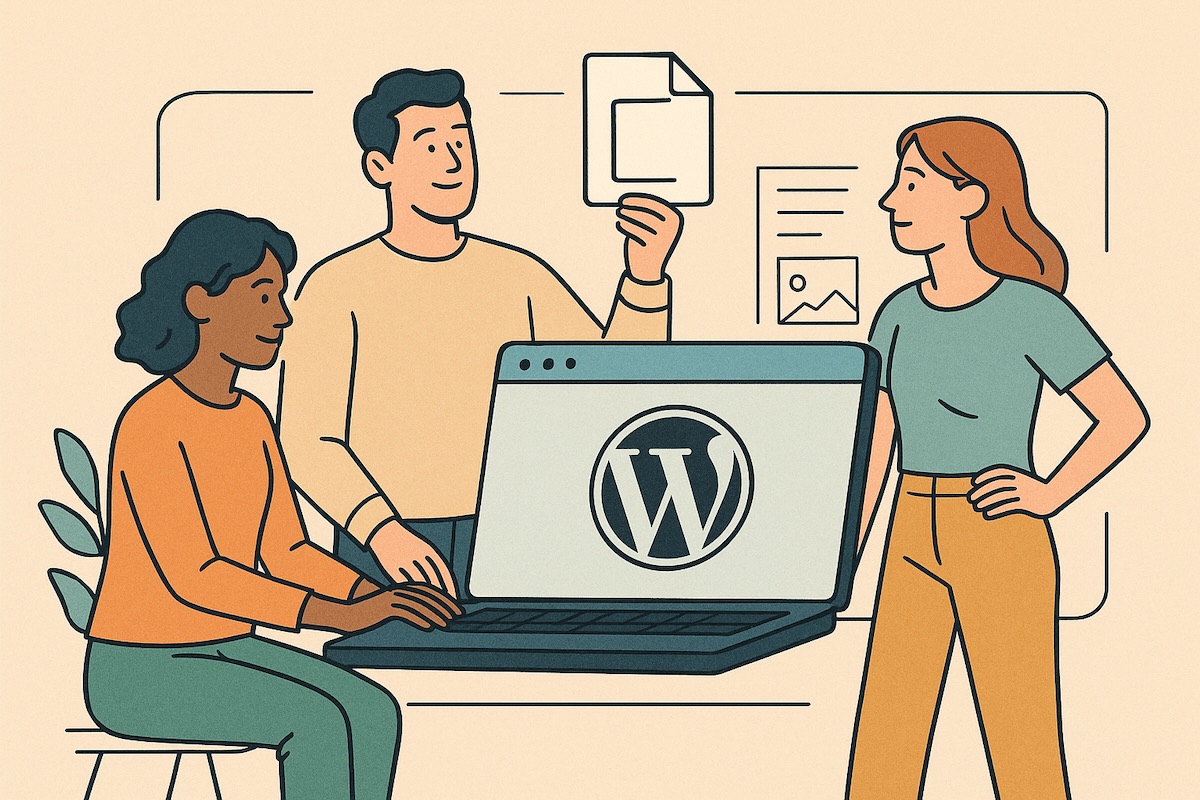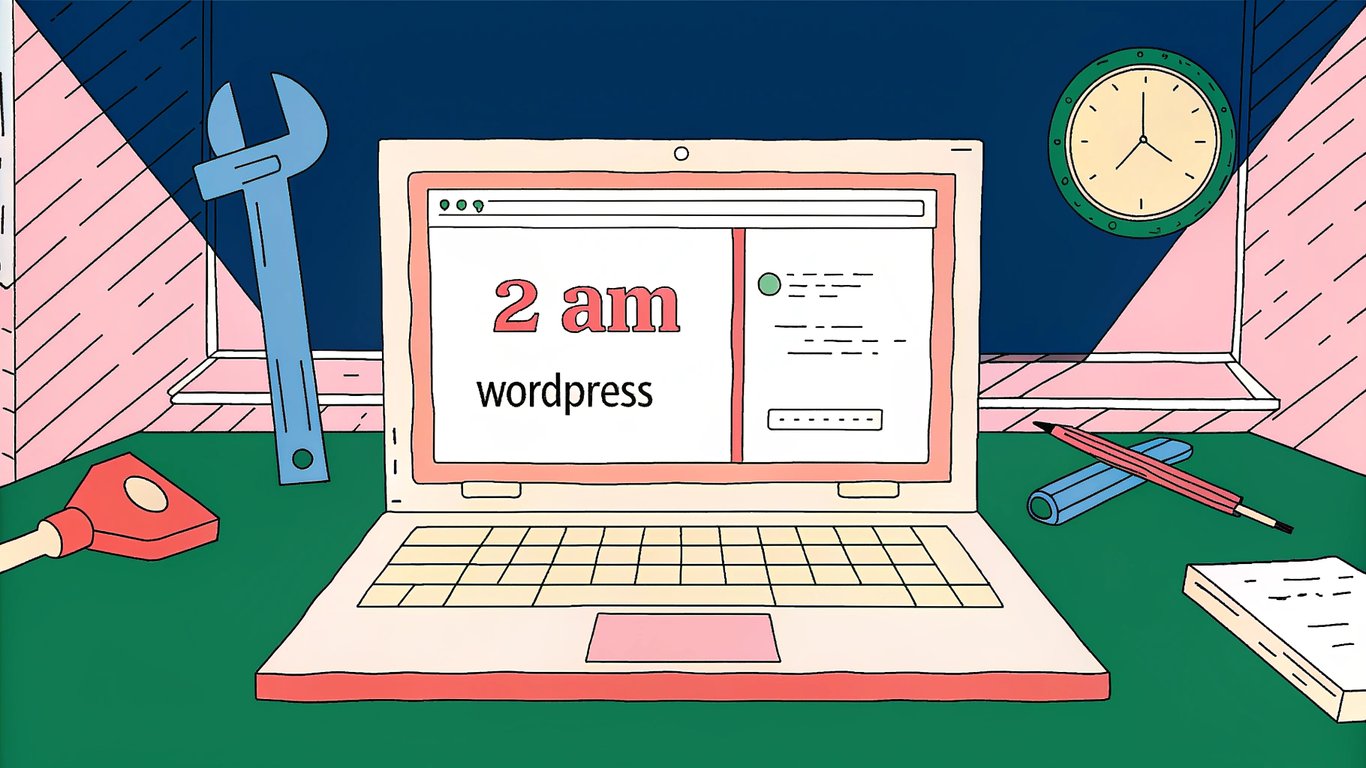Introduction to WordPress
WordPress is a content management system (CMS) that has revolutionized the way we build websites. Whether you're crafting a personal blog or a full-fledged business site, WordPress offers the tools you need to create a stunning online presence. But what exactly is WordPress, and why is it so popular?
What is WordPress?
At its core, WordPress is a website builder and blog platform that allows users to create and manage websites with ease. It's open-source, meaning it's free to use and can be customized to fit your needs. With a vast library of themes and plugins, WordPress is incredibly versatile, making it a favorite among beginners and professionals alike.
WordPress.org vs WordPress.com
One of the most common confusions for beginners is the difference between WordPress.org and WordPress.com. Let's break it down:
Feature | WordPress.org | WordPress.com |
|---|---|---|
Hosting | Self-hosted | Hosted by WordPress |
Customization | Full control over themes and plugins | Limited customization |
Cost | Free, but requires hosting | Free with paid upgrades |
Monetization | Full control | Limited options |
Domain | Custom domain required | Subdomain provided |
In essence, WordPress.org gives you the freedom to build a site exactly how you want, while WordPress.com offers a more managed experience. Your choice depends on your needs and technical comfort level.
Why Choose WordPress?
So, why do millions of users choose WordPress? Here are some compelling reasons:
- It's user-friendly, even for beginners.
- Offers extensive customization with themes and plugins.
- Supports SEO-friendly practices.
- Has a large, supportive community.
- Regular updates and security features.
WordPress powers over 40% of all websites on the internet, a testament to its popularity and reliability. Whether you're a blogger, a business owner, or a developer, WordPress provides the flexibility and power you need to succeed online.
For beginners, the most common concerns include understanding the difference between WordPress.org and WordPress.com, choosing the right hosting, and learning how to customize their site. Rest assured, with WordPress, you're in good hands.
Getting Started with WordPress
So, you're ready to kick off your WordPress adventure? Fantastic! Setting up your WordPress site is like laying the foundation for a new home. It's all about making the right choices from the get-go to ensure smooth sailing down the line. Let's break it down into bite-sized steps, starting with choosing a hosting provider.
Ready to build a strong foundation for your WordPress site? Explore our WordPress Basics & Setup tutorials to master the essentials of installation, hosting, themes, and must-have plugins. Whether you're just starting out or looking to refine your skills, these guides will help you lay the groundwork for a successful WordPress journey.

Choosing a Hosting Provider
Your hosting provider is essentially the landlord of your website. They provide the space where your site lives on the internet. When selecting a WordPress hosting provider, consider factors like reliability, speed, and customer support. A good host can make a world of difference in your site's performance and security.
- Research hosting providers that specialize in WordPress hosting.
- Look for providers offering 24/7 customer support.
- Check for scalability options to accommodate future growth.
- Consider the hosting provider's security features.
Remember, the right hosting provider can set the stage for a successful website setup. It's worth taking the time to compare options and read reviews.
Domain Name Selection
Your domain name is your website's address on the internet. It's how people will find you, so choose wisely! A memorable and relevant domain name can help establish your brand identity and improve your site's visibility.
- Keep it short and easy to spell.
- Avoid numbers and hyphens.
- Choose a domain name that reflects your brand or niche.
- Check for trademark issues to avoid legal complications.
Once you've settled on a domain name, you can register it through your hosting provider or a separate domain registrar. This step is crucial for your website setup and long-term success.
Installing WordPress
With your hosting and domain name sorted, it's time to install WordPress. This is where the magic happens! Most hosting providers offer a one-click installation process, making it easy for beginners to get started.
- Log in to your hosting account.
- Navigate to the control panel and find the WordPress installer.
- Follow the prompts to complete the installation.
- Set up your admin account with a strong password.
For those who prefer a manual approach, you can download WordPress from the official site and upload it to your server. This method offers more control but requires a bit more technical know-how.
Avoid common setup pitfalls by ensuring your WordPress installation is up-to-date and secure. Regular updates and backups are essential for maintaining a healthy site.
Ready to take the plunge and install WordPress like a pro? For an in-depth article on the topic visit How to Install WordPress in 2025: Complete Step-by-Step Guide for Beginners.
By following these steps, you're laying a solid foundation for your WordPress site. Proper initial setup is key to long-term success, so take your time and get it right. Happy building!
Understanding the WordPress Dashboard
Welcome to the heart of your WordPress site—the WordPress dashboard. This is where all the magic happens, from crafting new posts to tweaking your site's design. Let's explore how you can make the most of this powerful tool.
Dashboard Overview
When you first log in, the dashboard might seem like a bustling hub of options. But don't worry, it's more intuitive than it looks. The dashboard is your command center, offering a bird's-eye view of your site's activity and providing quick access to essential features.
- At a Glance: See your site's stats, including the number of posts, pages, and comments.
- Activity: Keep track of recent posts and comments.
- Quick Draft: Jot down ideas for new posts without leaving the dashboard.
- WordPress News: Stay updated with the latest WordPress news and updates.
Each section is designed to give you a snapshot of your site's health and activity. It's like having a dashboard in your car—everything you need is right in front of you.
Essential Settings Configuration
Configuring your settings is crucial for a smooth-running site. Let's break down the key settings you should focus on:
- General Settings: Set your site title, tagline, and timezone. These basics are vital for your site's identity.
- Reading Settings: Decide whether your homepage displays your latest posts or a static page.
- Permalinks: Choose how your URLs are structured. A clean URL structure is important for SEO.
- Discussion Settings: Manage how comments are handled on your site.
These settings are like the foundation of a house—get them right, and everything else will fall into place.
Navigation Tips
Navigating the WordPress dashboard is a breeze once you know a few shortcuts. Here are some tips to help you move around efficiently:
- Admin Bar: The top bar provides quick links to your site, new posts, and more.
- Left Sidebar: This is your main navigation area, with links to posts, pages, media, and settings.
- Screen Options: Customize what you see on each page by clicking the 'Screen Options' tab at the top.
- Help Tab: Stuck? Click the 'Help' tab for guidance specific to the page you're on.
Think of these tips as your GPS, guiding you through the dashboard with ease.
The WordPress dashboard is more than just a control panel—it's your creative playground. With the right settings and navigation skills, you'll be customizing your site like a pro in no time. Whether you're adjusting the site editor or exploring website customization options, the dashboard is your gateway to a world of possibilities.

Working with Themes and Customization
When it comes to wordpress themes, the choices can feel endless. But don't worry, picking the right theme is more about aligning with your website's purpose and your personal style than anything else. Let's explore how you can make your site truly yours.
Choosing the Right Theme
Selecting a theme is like choosing an outfit for your website. It should reflect your brand and be functional. Here are some criteria to consider:
- Purpose and Functionality: Ensure the theme supports the features you need, whether it's a blog, e-commerce, or portfolio site.
- Design and Aesthetics: Look for a design that resonates with your brand's identity.
- Responsiveness: Make sure the theme is mobile-friendly, as a significant portion of web traffic comes from mobile devices.
- Customization Options: Check if the theme allows easy customization without coding knowledge.
- Support and Updates: Opt for themes that are regularly updated and have good support.
Customizing Your Theme
Once you've chosen a theme, it's time to make it your own. Customization is where your creativity can shine, and the best part? You don't need to be a coding wizard to do it.
- Navigate to the Appearance section in your WordPress dashboard.
- Select Customize to open the theme customizer.
- Adjust the Site Identity by adding your logo and site title.
- Modify Colors and Fonts to match your brand's palette.
- Use Widgets to add functionality to your sidebar or footer.
- Preview changes on different devices to ensure mobile responsiveness.
Using the Block Editor
The block editor in WordPress is a game-changer for website customization. It allows you to build pages with a simple drag-and-drop interface, making it accessible for everyone.
- Start by creating a new page or post.
- Use the Add Block button to insert different types of content blocks like text, images, or videos.
- Customize each block's settings to fit your design needs.
- Experiment with layout blocks to create columns and sections.
- Utilize reusable blocks for content you want to use across multiple pages.
The block editor empowers you to create a visually appealing site without touching a single line of code. It's all about experimenting and finding what works best for your site.
Remember, the key to effective website customization is to keep your audience in mind. A well-designed site not only looks good but also enhances user experience. So, go ahead and let your creativity flow!

Creating and Managing Content
When it comes to building a successful website on WordPress, content management is at the heart of it all. Whether you're running a blog platform or a business site, understanding how to effectively create and manage your website content is crucial. Let's explore the essentials of content creation, from distinguishing between posts and pages to organizing your media and using categories and tags.
Posts vs Pages: What's the Difference?
In WordPress, content is primarily divided into two types: posts and pages. While they might seem similar at first glance, they serve different purposes.
Feature | Posts | Pages |
|---|---|---|
Purpose | Dynamic content like blog entries | Static content like 'About Us' |
Chronological Order | Displayed in reverse chronological order | Not time-sensitive |
Categories and Tags | Can be organized using categories and tags | Not typically categorized |
RSS Feeds | Included in RSS feeds | Not included in RSS feeds |
Posts are ideal for blog platforms where regular updates are necessary, while pages are perfect for static content that doesn't change often. Understanding this distinction helps in organizing your website content effectively.
Media Management: Keeping It All Together
The media library in WordPress is your go-to place for managing images, videos, and other files. It's essential to keep your media organized to ensure your site runs smoothly and looks professional.
- Upload media directly to the library or while creating a post/page.
- Use descriptive file names and alt text for better SEO.
- Organize media into folders or use plugins for advanced management.
By maintaining a well-organized media library, you enhance your site's content management capabilities and improve its overall performance.
Categories and Tags: Organizing Your Content
Categories and tags are powerful tools for organizing your website content. They help users navigate your site and improve your SEO by structuring your content logically.
- Categories are broad groupings of your posts. Think of them as the table of contents for your site.
- Tags are more specific and describe details of your posts. They act like the index of a book.
- Use a mix of categories and tags to create a comprehensive content structure.
Proper use of categories and tags not only aids in content management but also enhances user experience by making it easier for visitors to find related content.
SEO Best Practices for Content
SEO is a critical component of website content strategy. By following best practices, you can ensure your content reaches a wider audience.
- Use relevant keywords naturally throughout your content.
- Optimize images with alt text and descriptive file names.
- Ensure your site is mobile-friendly and loads quickly.
By integrating these SEO practices, you enhance your site's visibility and attract more visitors, making your blog platform or business site more successful.
Content Planning Tips: Stay Ahead of the Game
Planning your content in advance can save you time and ensure consistency. Here are some tips to keep your content management on track:
- Create a content calendar to schedule posts and updates.
- Research trending topics and incorporate them into your content.
- Regularly review and update old content to keep it relevant.
By staying organized and proactive, you can maintain a steady flow of engaging content that keeps your audience coming back for more.
Essential WordPress Plugins
When it comes to enhancing your WordPress site, plugins are your best friends. They add functionality, improve performance, and can even boost security. But with thousands of options available, how do you choose the right ones? Let's explore some must-have plugins and how to manage them effectively.
Must-Have WordPress Plugins
Selecting the right plugins can transform your website from basic to brilliant. Here are some essential categories and examples to consider:
- SEO Plugins: Optimize your site for search engines. Popular choices include Yoast SEO and All in One SEO Pack.
- Security Plugins: Protect your site from threats. Consider using Wordfence or Sucuri Security.
- Performance Plugins: Speed up your site with caching solutions like W3 Total Cache or WP Super Cache.
- Backup Plugins: Safeguard your data with plugins like UpdraftPlus or BackupBuddy.
- Contact Form Plugins: Easily add contact forms with plugins like Contact Form 7 or WPForms.
Plugin Installation and Management
Installing a plugin is a breeze. Simply head to your WordPress dashboard, click on 'Plugins', and then 'Add New'. From there, you can search for plugins by name or feature. Once you find the one you want, click 'Install Now' and then 'Activate'.
Managing plugins is just as important as installing them. Regularly update your plugins to ensure they are secure and compatible with the latest version of WordPress. Deactivate and delete any plugins you no longer use to keep your site running smoothly.
Free vs Premium Plugins
While free plugins offer great functionality, premium plugins often provide additional features and dedicated support. Here's a quick comparison to help you decide:
Feature | Free Plugins | Premium Plugins |
|---|---|---|
Cost | Free | Paid |
Support | Community-based | Dedicated support |
Features | Basic | Advanced |
Updates | Regular | Priority |
Remember, the right plugins can significantly enhance your website customization and security. Choose wisely and manage them well to keep your site in top shape.
WordPress Security and Maintenance
Keeping your WordPress site secure and well-maintained is like ensuring your home is locked and tidy. It's not just about setting things up; it's about ongoing care and vigilance. Let's explore some essential practices to keep your site safe and running smoothly.

Security Best Practices
Security is a top priority for any website owner. With WordPress, there are several security fundamentals you should follow to protect your site from threats. Start by using strong passwords and changing them regularly. Consider enabling two-factor authentication for an extra layer of security.
Another key aspect is keeping your WordPress core, themes, and plugins updated. Updates often include patches for vulnerabilities, so staying current is crucial. You might wonder, "How often should I update?" Ideally, check for updates weekly and apply them promptly.
Don't forget about firewalls and security plugins. These tools can help block malicious traffic and monitor your site for suspicious activity. Popular options include Wordfence and Sucuri, which offer comprehensive protection features.
Regular Maintenance Tasks
Just like a car needs regular oil changes, your WordPress site requires routine maintenance to perform at its best. Here's a checklist to keep your site in tip-top shape:
- Check for and apply updates to WordPress core, themes, and plugins.
- Review and delete unused plugins and themes to reduce vulnerabilities.
- Optimize your database by removing unnecessary data and revisions.
- Test your site's speed and performance using tools like GTmetrix or Google PageSpeed Insights.
- Regularly review user accounts and permissions to ensure only authorized users have access.
Backup Strategies
Imagine losing all your hard work due to a server crash or a hack. That's where wordpress backup solutions come in. Regular backups are your safety net, allowing you to restore your site to a previous state if something goes wrong.
There are several backup options available, ranging from manual backups to automated solutions. Let's compare a few popular choices:
Backup Method | Pros | Cons |
|---|---|---|
Manual Backups | Complete control over backup process | Time-consuming and prone to human error |
Plugin-Based Backups | Automated and easy to schedule | May require premium versions for full features |
Hosting Provider Backups | Often included in hosting plans | Limited control over backup frequency |
For peace of mind, consider using a combination of these methods. Plugins like UpdraftPlus or BackupBuddy offer reliable solutions for automated backups, while your hosting provider might offer additional backup services.
In conclusion, maintaining your WordPress site involves a mix of security measures, regular upkeep, and reliable backup strategies. By following these practices, you can ensure your site remains secure and performs optimally, giving you more time to focus on creating great content.
SEO and Performance Optimization
When it comes to making your WordPress site shine, SEO and performance optimization are your best friends. These elements not only help your site rank higher in search results but also ensure a smooth user experience. Let's explore how you can enhance your website's visibility and speed.
WordPress SEO Basics
SEO, or Search Engine Optimization, is all about making your site more attractive to search engines. This involves using the right keywords, optimizing your content, and ensuring your site is easy to navigate. But how do you get started with SEO on WordPress?
- Choose an SEO-friendly theme that supports clean code and fast loading times.
- Install an SEO plugin to help manage your site's metadata and sitemaps.
- Conduct keyword research to find terms your audience is searching for.
- Optimize your content with these keywords, but keep it natural and engaging.
- Ensure your site is mobile-friendly, as search engines prioritize mobile responsiveness.
SEO Plugin | Features | Price |
|---|---|---|
Yoast SEO | Comprehensive SEO management, readability analysis | Free/Premium |
All in One SEO Pack | XML sitemaps, Google Analytics support | Free/Premium |
Rank Math | SEO analysis, keyword optimization | Free/Premium |
Speed Optimization
A fast website is crucial for both user satisfaction and search engine rankings. Slow loading times can lead to higher bounce rates, which negatively impact your site's performance metrics. So, how can you boost your site's speed?
- Use a reliable hosting provider that offers fast server response times.
- Optimize images by compressing them without losing quality.
- Leverage browser caching to reduce load times for returning visitors.
- Minimize HTTP requests by combining CSS and JavaScript files.
- Utilize a content delivery network (CDN) to distribute your content globally.
Mobile Responsiveness
With more users accessing websites via mobile devices, ensuring your site is mobile-friendly is essential. Mobile responsiveness not only improves user experience but also boosts your site's SEO. Here's how you can achieve it:
- Choose a responsive WordPress theme that adapts to different screen sizes.
- Test your site's mobile performance using tools like Google's Mobile-Friendly Test.
- Optimize your site's layout to ensure easy navigation on smaller screens.
- Use larger fonts and buttons to enhance usability on touch devices.
- Regularly update your site to fix any mobile display issues.
By focusing on wordpress optimization, website performance, and mobile responsiveness, you can significantly improve your site's search rankings and user experience. Remember, a well-optimized site is not just about speed and SEO; it's about creating a seamless experience for your visitors.
Monetization and Analytics
Turning your WordPress site into a revenue-generating machine is a dream for many. But how do you make it happen? Let's explore some effective website monetization strategies and how to keep track of your site's performance with analytics.
WordPress Monetization Methods
There are numerous ways to monetize your WordPress site, each with its own perks and challenges. Here are some popular options to consider:
- Affiliate Marketing: Promote products or services and earn a commission for each sale made through your referral links.
- Advertising: Use platforms like Google AdSense to display ads on your site and earn money based on clicks or impressions.
- Membership Sites: Offer exclusive content or services to paying members.
- Online Courses: Create and sell educational content directly from your site.
- eCommerce: Sell physical or digital products using plugins like WooCommerce.

Setting Up Analytics
To make informed decisions about your monetization strategies, you need to understand your audience. This is where analytics tracking comes into play. Setting up analytics on your WordPress site is crucial for monitoring traffic and understanding user behavior.
Google Analytics is a popular choice for many website owners. It provides comprehensive insights into your site's performance, including visitor demographics, traffic sources, and user engagement.
Analytics Tool | Features | Best For |
|---|---|---|
Google Analytics | Comprehensive traffic analysis, user behavior insights | General website tracking |
Jetpack Stats | Basic traffic stats, easy integration | Beginners |
MonsterInsights | Google Analytics integration, eCommerce tracking | Advanced users |
Traffic Analysis
Understanding your site's traffic is key to optimizing your monetization efforts. By analyzing traffic patterns, you can identify which content resonates most with your audience and adjust your strategies accordingly.
Regularly reviewing your analytics data helps in traffic analysis and ensures you're on the right track. Look for trends in visitor numbers, bounce rates, and session durations to gauge the effectiveness of your content and marketing efforts.
Don't forget to track revenue alongside traffic metrics. This will help you understand the correlation between your site's performance and your earnings, allowing for more strategic adjustments.
Incorporating these monetization and analytics strategies can transform your WordPress site into a thriving business. Keep experimenting and analyzing to find what works best for your audience and goals.
Troubleshooting Common Issues
Running into issues with WordPress? You're not alone! Whether you're a newbie or a seasoned pro, WordPress troubleshooting can sometimes feel like a puzzle. But don't worry, we've got you covered with some common errors and their solutions.
Common WordPress Errors
WordPress is a powerful platform, but like any software, it can encounter hiccups. Here are some frequent errors users face:
Error | Description | Solution |
|---|---|---|
500 Internal Server Error | A generic error indicating something went wrong on the server. | Check .htaccess file, increase PHP memory limit. |
404 Not Found | The requested page cannot be found. | Verify URL, check permalink settings. |
White Screen of Death | A blank screen with no error message. | Disable plugins, switch to a default theme. |
Error Establishing Database Connection | WordPress cannot connect to the database. | Check wp-config.php for correct database credentials. |
Problem-Solving Steps
When faced with an error, a systematic approach can save the day. Here's a step-by-step guide to resolving issues:
- Identify the error message or symptom.
- Search for the error in the WordPress support forums or official documentation.
- Deactivate all plugins to see if one is causing the issue.
- Switch to a default theme to rule out theme-related problems.
- Check for recent changes or updates that might have triggered the error.
- Review server logs for more detailed error information.
Getting Support
Sometimes, despite your best efforts, you might need a little extra help. Here's where you can turn for support:
- WordPress Support Forums: A great place to ask questions and find answers from the community.
- Technical Support: Many hosting providers offer 24/7 support for WordPress issues.
- Professional Help: Consider hiring a WordPress developer for complex problems.
- Prevention Strategies: Regularly update WordPress, themes, and plugins to minimize issues.
Remember, while WordPress troubleshooting can be challenging, it's also an opportunity to learn and improve your skills. And when in doubt, the WordPress community is always there to lend a hand!
Advanced WordPress Features
For those who have mastered the basics of WordPress, it's time to explore some of the more advanced features that can take your website to the next level. Whether you're looking to create custom content types, integrate with external applications, or manage multiple sites from a single dashboard, WordPress has you covered.
Custom Post Types
Custom Post Types (CPTs) allow you to create content that goes beyond the standard posts and pages. Imagine having a dedicated section for portfolios, testimonials, or even recipes. With CPTs, you can structure your content in a way that best suits your needs.
- Organize content more effectively
- Enhance user experience with tailored content types
- Improve SEO by structuring content logically
Creating a custom post type involves a bit of coding, but don't worry—there are plenty of plugins that can help you set this up without writing a single line of code. For those interested in the technical side, the WordPress Developer Handbook is a great resource.
WordPress REST API
The WordPress REST API is a powerful tool that allows developers to interact with WordPress sites remotely. This means you can build applications that can create, read, update, and delete content on your WordPress site from anywhere in the world.
- Integrate with third-party applications
- Create custom mobile apps
- Automate content management tasks
For developers, the REST API opens up a world of possibilities. You can learn more about how to use it in the WordPress REST API Handbook.
Multisite Networks
If you're managing multiple WordPress sites, the Multisite feature is a game-changer. It allows you to run multiple sites from a single WordPress installation, making it easier to manage updates, themes, and plugins across all your sites.
- Centralized management of multiple sites
- Shared themes and plugins
- Streamlined updates and maintenance
Setting up a Multisite network requires some initial configuration, but the benefits are well worth it. For a detailed guide, check out the WordPress Codex.
Feature | Description | Use Case |
|---|---|---|
Custom Post Types | Create unique content types | Portfolios, Testimonials |
REST API | Interact with WordPress remotely | Mobile Apps, Third-party Integrations |
Multisite Networks | Manage multiple sites from one dashboard | Corporate Websites, Educational Institutions |
These advanced features of WordPress open up a plethora of opportunities for customization and scalability. Whether you're a developer looking to build complex applications or a site owner managing multiple sites, these tools can significantly enhance your WordPress experience.
Conclusion and Next Steps
As we wrap up this guide on how to use WordPress, it's clear that mastering this platform opens up a world of possibilities in website development and content management. Whether you're just starting or looking to refine your skills, WordPress offers a robust foundation for building and managing your online presence.
Summary of Key Points
Section | Key Takeaways |
|---|---|
Introduction to WordPress | Understanding WordPress.org vs WordPress.com |
Getting Started with WordPress | Choosing hosting and domain names |
Understanding the WordPress Dashboard | Navigating essential settings |
Working with Themes and Customization | Selecting and customizing themes |
Creating and Managing Content | Organizing posts and pages effectively |
Essential WordPress Plugins | Selecting must-have plugins |
WordPress Security and Maintenance | Implementing security best practices |
SEO and Performance Optimization | Enhancing site speed and SEO |
Monetization and Analytics | Setting up analytics and monetization |
Troubleshooting Common Issues | Resolving frequent WordPress errors |
Advanced WordPress Features | Exploring custom post types and APIs |
WordPress Learning Resources
Continuous learning is key to staying ahead in the WordPress ecosystem. Here are some resources to help you deepen your knowledge and skills:
- WordPress Support Forums for community-driven help
- WordPress Developer Resources for technical insights
- Online Courses on platforms like Udemy for structured learning
- WordPress Meetups for networking and community engagement
Future WordPress Trends
Looking ahead, WordPress continues to evolve with exciting trends that promise to enhance website development and content management. From the growing use of Gutenberg block editor to the integration of AI tools for content creation, the future is bright. Staying engaged with the community and keeping an eye on these trends will ensure you remain at the forefront of WordPress innovation.
In conclusion, your journey with WordPress is just beginning. Embrace the learning opportunities, connect with the community, and explore the endless possibilities that WordPress offers. Happy building!



